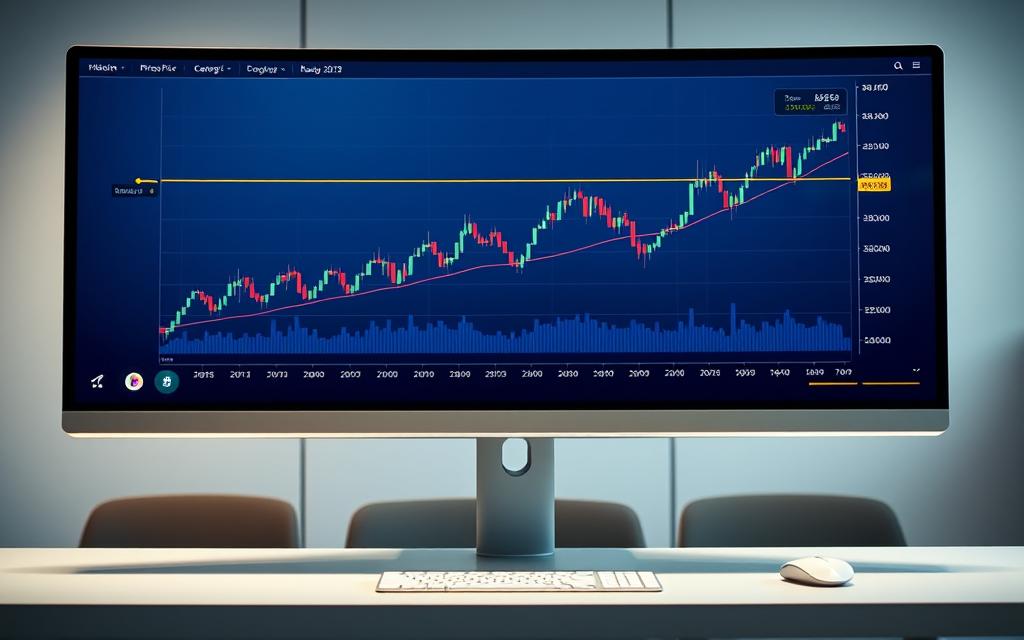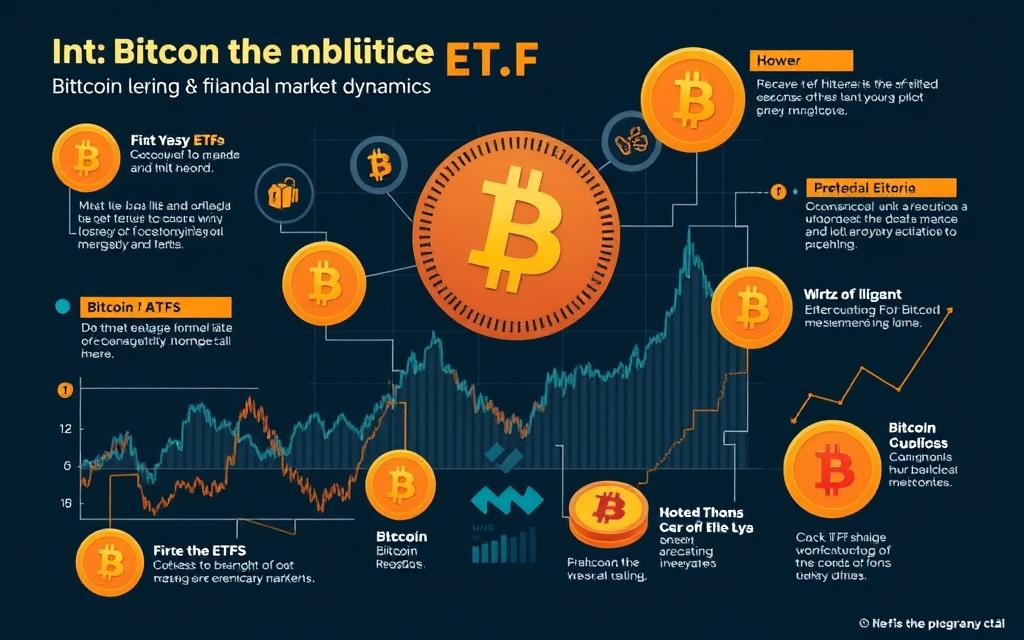Table of Contents
On May 22, Bitcoin hit a new all-time high of $112,000, sparking a heated debate among investors about its future trajectory. While some believe it’s a signal for continued growth, others warn that it may be overpriced at such high levels.
The cryptocurrency market is known for its volatility, and investors are closely watching the price to make informed decisions. As the market continues to evolve, it’s essential to examine the conflicting viewpoints among investors and analysts.
This analysis will explore the recent price performance and historical patterns to provide insights into Bitcoin’s potential future. By examining expert opinions and market cycles, we’ll provide a comprehensive understanding of the potential scenarios for retail investors.
The Current State of Bitcoin: Record Highs and Market Sentiment
With Bitcoin’s value soaring to unprecedented levels, the market is now grappling with the implications of its remarkable growth. As the cryptocurrency continues to break new records, its impact on the global financial landscape is becoming increasingly significant.
Bitcoin’s Recent Price Performance
Bitcoin’s recent price performance has been nothing short of extraordinary, with its value skyrocketing to new heights. This surge has been driven by a combination of factors, including increased adoption and investment from both retail and institutional investors. The cryptocurrency’s price is now closely watched by market analysts and investors alike, as it continues to influence the broader financial market.
Market Capitalization and Global Standing
Bitcoin’s market capitalization has reached an impressive $2.2 trillion, catapulting it into the ranks of the world’s most valuable assets. It now stands alongside tech giants like Apple, Nvidia, and Microsoft, as well as gold, in terms of market capitalization. This remarkable valuation is a testament to the growing recognition of Bitcoin as a legitimate asset class.
| Asset | Market Capitalization | Global Ranking |
|---|---|---|
| Apple | $2.5 trillion | 1st |
| Nvidia | $2.3 trillion | 2nd |
| Microsoft | $2.2 trillion | 3rd |
| Gold | $2.1 trillion | 4th |
| Bitcoin | $2.2 trillion | 5th |
The significant growth in Bitcoin’s market cap has been largely driven by institutional investors, who have allocated substantial portions of their treasuries to the cryptocurrency. This has not only elevated Bitcoin’s status as a global asset but also sparked a debate about its potential as “digital gold” and a store of value.
Understanding Bitcoin’s Historical Cycles
The cryptocurrency market, particularly Bitcoin, has been characterized by dramatic boom and bust cycles that have captivated investors worldwide. These cycles are not random; they follow patterns that can be analyzed to predict future market trends.

The Four-Year Bitcoin Cycle Explained
Bitcoin’s history is marked by a four-year cycle, closely tied to its halving events. This cycle has seen the cryptocurrency’s price increase by over 1,000% during bull markets, followed by corrections of 70-85%. For instance, the 2017-2018 cycle saw Bitcoin hit a then-all-time high of nearly $20,000 before experiencing a steep decline to approximately $3,200, representing an 84% drawdown. Understanding this cycle is crucial for investors looking to capitalize on Bitcoin’s potential.
The current cycle leading to the all-time high of $112,000 in 2025 has shown patterns remarkably similar to previous cycles, with a post-halving rally followed by periods of consolidation and renewed momentum.
Previous Boom and Bust Patterns
Historical data indicates that Bitcoin’s price corrections tend to find support at levels significantly higher than previous cycle peaks. For example, after reaching $69,000 in 2021, Bitcoin’s price fell to $16,000 in 2022 but remained above the previous cycle’s peak. This pattern suggests that even if a crash occurs, it may not fall below certain key historical levels.
The rally in Bitcoin’s price over the years has been remarkable, with each cycle pushing the cryptocurrency to hit new heights. As the price continues to fluctuate, understanding these historical patterns can help investors make informed decisions about their investments.
The Bullish Case: Why Bitcoin Could Continue to Rise
The prospect of Bitcoin’s continued growth is bolstered by a robust set of factors, including expanding mainstream adoption and the cryptocurrency’s evolving role as a safe-haven asset. As the cryptocurrency landscape continues to mature, several key drivers are likely to influence Bitcoin’s trajectory.
Mainstream Adoption Driving Growth
Mainstream adoption is a critical factor driving Bitcoin’s growth. As more businesses and individuals begin to accept and invest in Bitcoin, its utility and value proposition are enhanced. This growing recognition is reflected in the increasing number of companies incorporating Bitcoin into their financial strategies. Mainstream acceptance is crucial for sustained growth, as it helps to reduce volatility and increase liquidity in the market.
- Increasing corporate investment in Bitcoin
- Growing acceptance of Bitcoin as a form of payment
- Expansion of Bitcoin-related financial products
Institutional Investment and ETF Inflows
Institutional investment has played a pivotal role in Bitcoin’s recent price performance. The introduction of Bitcoin ETFs (Exchange-Traded Funds) has made it easier for institutional investors to gain exposure to the cryptocurrency. This influx of institutional capital has contributed to increased market stability and legitimacy. As more institutional investors enter the market, it is likely to drive further growth.
Bitcoin as a Safe Haven Asset
Bitcoin’s narrative as “digital gold” has gained traction during periods of economic uncertainty, particularly following Donald Trump’s implementation of broad tariffs in April 2025. The cryptocurrency’s borderless nature and immunity to tariffs have made it increasingly attractive as a safe-haven asset. Historical data shows that Bitcoin has demonstrated periods of non-correlation with traditional asset classes, potentially offering portfolio diversification benefits during market turbulence.
- Bitcoin’s non-correlation with traditional assets
- Increasing appeal as a hedge against inflation and currency debasement
- Growing recognition as a legitimate store of value
The Bearish Case: Is Bitcoin Going to Crash?
A closer look at the current market reveals several bearish signs for Bitcoin. Despite the recent rally, concerns about overvaluation, speculative excess, and historical precedents for major corrections are mounting.
Overvaluation Concerns
Bitcoin’s price has surged significantly, raising concerns about its valuation. The rapid appreciation has outpaced fundamental value, leading some analysts to warn of a potential correction. With the bitcoin price reaching new heights, investors are increasingly cautious about the sustainability of this rally.
Speculative Excess in the Crypto Market
The crypto market is experiencing a surge in speculative activity, with many investors buying into the rally without a clear understanding of the underlying assets. This speculative excess can lead to a sharp correction when market sentiment shifts. The recent events in the crypto space have highlighted the risks associated with speculative investments.
Historical Precedents for Major Corrections
Bitcoin’s history is marked by significant corrections following periods of rapid growth. For instance, the 2017-2018 cycle saw an 84% drop from $20,000 to $3,200 over approximately one year. Similarly, the 2021-2022 correction resulted in a 70% drawdown from $69,000 to around $16,000 following the FTX collapse. These historical patterns suggest that Bitcoin’s current price levels could be vulnerable to a correction of similar magnitude, potentially bringing prices down to the $30,000-$40,000 range.
| Year | Peak Price | Low Price | % Decline |
|---|---|---|---|
| 2017-2018 | $20,000 | $3,200 | 84% |
| 2021-2022 | $69,000 | $16,000 | 70% |
As the market continues to evolve, understanding these historical precedents is crucial for investors. The potential for a steep decline in Bitcoin’s price is a risk that investors must consider when making investment decisions.

Expert Predictions: From $10,000 to $200,000
Bitcoin’s price trajectory is a topic of intense debate among analysts, with forecasts ranging from $10,000 to $200,000. While some experts are bearish, others are bullish on the cryptocurrency’s prospects.
Bearish Forecasts and Their Rationale
Some analysts remain cautious about Bitcoin’s future, citing concerns about market volatility and regulatory challenges. However, the prevailing sentiment among many experts is that Bitcoin could soar in the coming years.
Despite the bearish views, there is evidence to support more optimistic predictions. For instance, on-chain analysts point to decreasing exchange balances and growing illiquid supply as indicators of strong underlying fundamentals.
Bullish Price Targets and Supporting Evidence
Bullish analysts argue that Bitcoin’s price could reach new heights driven by factors such as institutional adoption and ETF inflows. Several prominent firms have made predictions that reflect this optimism.
- Bernstein analysts maintain a $200,000 Bitcoin price target for 2025, citing institutional ETF inflows exceeding $70 billion and favorable regulatory developments.
- Standard Chartered’s research team projects Bitcoin could reach $200,000-$250,000, based on accelerating adoption by U.S. retirement funds.
- H.C. Wainwright & Co. analysts forecast a $225,000 price target, supported by growing corporate adoption and spot ETF traction.
| Analyst Firm | Price Target | Rationale |
|---|---|---|
| Bernstein | $200,000 | Institutional ETF inflows, regulatory developments |
| Standard Chartered | $200,000-$250,000 | Adoption by U.S. retirement funds |
| H.C. Wainwright & Co. | $225,000 | Corporate adoption, ETF traction |

The diversity of analyst predictions highlights the complexity of forecasting Bitcoin’s price. As the cryptocurrency market continues to evolve, it is essential to consider multiple perspectives when evaluating future prospects.
The Impact of Macroeconomic Factors
Understanding the macroeconomic landscape is crucial for assessing Bitcoin’s future. As global economic conditions evolve, they significantly influence the cryptocurrency market.
Global Economic Uncertainty
Global economic uncertainty has a profound impact on Bitcoin’s price. During times of economic stress, investors often seek safe-haven assets. Bitcoin’s role as a safe haven is still debated, but its correlation with traditional assets increases during market turmoil. As Wall Street sheds overvalued stocks, Bitcoin, being a high-beta asset tied to equity trends, feels the heat.
Inflation and Monetary Policy
Inflation and monetary policy decisions also play a critical role in shaping Bitcoin’s market dynamics. Expansionary monetary policies can lead to increased investment in risk assets, including cryptocurrencies. Conversely, tightening monetary policies can trigger sell-offs. The interplay between inflation expectations and Bitcoin’s price is complex, with some viewing it as a hedge against inflation.
Correlation with Traditional Markets
Bitcoin’s correlation with traditional equity markets, particularly technology stocks, has increased significantly during periods of market stress. This challenges the diversification benefits often cited by cryptocurrency proponents. The table below illustrates the growing correlation between Bitcoin and traditional markets.
| Asset | Correlation with Bitcoin (2020) | Correlation with Bitcoin (2023) |
|---|---|---|
| S&P 500 | 0.2 | 0.5 |
| Nasdaq | 0.3 | 0.6 |
| Gold | 0.1 | 0.3 |
As the data indicates, Bitcoin’s correlation with major stock indices has increased, suggesting that it is more closely tied to traditional market movements than previously thought. This has implications for investors seeking diversification.
Trump’s Tariff Wars and Their Effect on Bitcoin
The ongoing trade tensions sparked by Trump’s tariff wars have introduced a new dynamic into the cryptocurrency market. As the global economic landscape shifts, Bitcoin’s role as both a risk asset and a potential safe haven is being tested.

Trade Tensions and Crypto Markets
Bitcoin’s price action following major policy announcements has shown varying patterns, with initial volatility eventually giving way to trends that reflect the cryptocurrency’s evolving relationship with macroeconomic factors. The implementation of tariffs and resulting economic uncertainty has tested Bitcoin’s positioning, with market participants closely monitoring its performance during these policy-driven stress events.
- The borderless nature of Bitcoin has been emphasized as a potential advantage during trade wars.
- Regulatory responses to economic challenges could indirectly benefit Bitcoin by highlighting its censorship-resistant properties.
Bitcoin’s Response to Policy Shifts
The cryptocurrency’s value proposition is being reassessed in light of long-term policy shifts toward economic nationalism and reduced globalization. As economic uncertainty mounts, retail investors are particularly concerned about Bitcoin’s “global currency” appeal faltering. The market is watching closely to see if Bitcoin could hit new highs or face a significant correction in response to these macroeconomic events.
In conclusion, the way Bitcoin responds to Trump’s tariff wars will be a significant indicator of its future as a global currency.
Wall Street’s Risk-Off Mood and Crypto Correlation
The current risk-off mood on Wall Street is impacting Bitcoin, a high-beta asset closely linked to equity market trends. As investors become more risk-averse, the correlation between Bitcoin and traditional markets becomes more pronounced.
Institutional Sentiment Shifts
Institutional investors are increasingly influencing Bitcoin’s price movements. The introduction of Bitcoin ETFs has made it easier for retail investors to enter the market, but it has also led to a more volatile investor base. As a result, sentiment shifts among institutional investors can significantly impact Bitcoin’s price.
- Retail investors who entered the market through ETFs often lack the conviction of long-term holders.
- The influx of institutional investment has increased Bitcoin’s correlation with traditional assets.
Bitcoin as a High-Beta Asset
Bitcoin has demonstrated characteristics of a high-beta asset, experiencing price movements 2-3 times more extreme than broader market indices. This behavior is more pronounced as institutional involvement increases, with professional traders using Bitcoin as a leveraged play on market direction.
| Asset | Beta | Price Movement |
|---|---|---|
| Bitcoin | High | 2-3x Market Indices |
| Traditional Assets | Low-Moderate | In line with Market Indices |

Technical Analysis: Key Support and Resistance Levels
As we examine the current bitcoin price, understanding key support and resistance levels becomes crucial for predicting future market movements. Technical analysis provides valuable insights into potential price fluctuations, helping investors make informed decisions.
Critical Price Points to Watch
Bitcoin’s recent all-time high has drawn significant attention to critical price points that could influence future price movements. Key levels to watch include Fibonacci retracement levels, which suggest potential correction targets at $78,000 (38.2%), $65,000 (50%), and $52,000 (61.8%). These levels are derived from the move from the 2022 lows to the 2025 all-time high, providing a framework for evaluating the severity of any potential crash.

Chart Patterns and Their Implications
Examining price chart patterns on long-term timeframes reveals concerning similarities to previous market cycle tops. Potential double top formations, bearish divergences on momentum indicators, and declining volume during price advances are all indicators that retail investors should monitor closely. The weekly chart also reveals a potential rising wedge pattern, a bearish formation that typically resolves with a significant correction. Historically, such patterns have preceded major adjustments in bitcoin’s price over the past year.
Understanding these technical indicators can help investors prepare for potential 30-40% corrections as part of normal market behavior during extended bull cycles.
Bitcoin vs. Gold: The Digital Gold Narrative Under Scrutiny
Investors are increasingly scrutinizing the ‘digital gold’ narrative surrounding Bitcoin, comparing its performance to that of gold. The recent surge in gold’s value, with a 16% rise in 2025, underscores a shift away from speculative assets. According to McGlone, the Bitcoin-to-gold ratio is expected to revert to its previous levels, potentially accelerating Bitcoin’s decline as retail investors pivot to physical gold.

Performance Comparison in Times of Uncertainty
In times of economic uncertainty, the performance of Bitcoin and gold has shown divergence. Institutional capital flows have increasingly favored gold due to its established history as a reliable store of value. The divergence is evident in the allocation strategies of traditional asset managers, who demonstrate a growing preference for gold over Bitcoin.
Shifting Investor Preferences
Retail investor sentiment has begun to shift as Bitcoin’s volatility during recent market turbulence has undermined its positioning as a reliable store of value comparable to gold. Exchange-traded products tracking gold have seen consistent inflows during periods when Bitcoin ETFs experienced outflows, indicating a potential rotation between these crypto and traditional assets among investors seeking inflation protection or crisis hedges.
The Role of Bitcoin ETFs in Market Dynamics

The advent of spot Bitcoin ETFs has marked a new era in cryptocurrency investment, altering traditional market structures. In May, more than $1.5 billion flowed into these ETFs immediately after Bitcoin hit a new all-time high, setting up the month to be the best ever for spot Bitcoin ETF inflows.
The introduction of spot Bitcoin ETFs has fundamentally altered market structure by creating a new vector for capital flows that operates through traditional financial infrastructure rather than cryptocurrency-specific channels. This shift has significant implications for market dynamics.
Retail vs. Institutional ETF Flows
The influx of capital into Bitcoin ETFs can be attributed to both retail and institutional investors. Understanding the dynamics between these two groups is crucial for analyzing market trends. Institutional investment, in particular, brings a level of sophistication and stability to the market.
Long-term Impact on Bitcoin’s Price Stability
The long-term impact of Bitcoin ETFs on the price stability of Bitcoin is a topic of considerable interest. Several factors suggest that ETFs could contribute to reduced volatility. The arbitrage mechanism underlying ETF creation and redemption provides additional market efficiency and liquidity that could help dampen extreme price swings during periods of market stress.
Key points to consider include:
- The increasing institutionalization of Bitcoin ownership through ETFs could lead to more sophisticated risk management practices.
- Historical evidence from gold ETFs suggests that as these products mature, they tend to attract more stable, long-term capital.
- The evolving regulatory framework surrounding Bitcoin ETFs will play a crucial role in determining their long-term impact on price stability.
As Bitcoin continues on its trajectory, the role of ETFs in shaping its market dynamics will be closely watched. The way these investment vehicles evolve will likely have a significant impact on the future of cryptocurrency investment.
Liquidity Concerns and Market Depth
As Bitcoin continues to hit new all-time highs, concerns about liquidity and market depth become increasingly relevant. The cryptocurrency market is known for its volatility, and understanding the factors that influence liquidity is crucial for investors.

Exchange Order Books and Selling Pressure
Exchange order books play a critical role in understanding market liquidity. A deep order book with a significant volume of buy and sell orders indicates a liquid market, capable of absorbing large trades without significant price movements. However, a shallow order book can lead to substantial price swings in response to large trades, exacerbating selling pressure during market downturns.
Recent data suggests that major players are moving their funds into cold storage, indicating long-term holding intentions rather than planning to sell, even if prices fall further.
Whale Movements and Their Market Impact
On-chain data reveals significant accumulation behavior among Bitcoin “whales,” with these large holders increasingly moving assets to cold storage. Historical analysis shows that these sophisticated investors often accumulate during price declines and distribute during extreme bullish euphoria, serving as a stabilizing force in the market.
| Indicator | Description | Impact on Market |
|---|---|---|
| Whale Accumulation | Large holders moving assets to cold storage | Reduces available supply, potentially stabilizing price |
| Exchange Order Book Depth | Volume of buy and sell orders | Influences market liquidity and volatility |
| Selling Pressure | Large trades in shallow order books | Can lead to significant price movements |
Preparing Your Investment Strategy: Risk Management Approaches
As Bitcoin’s price continues to fluctuate, investors must adapt their strategies to manage risk effectively. The cryptocurrency market is known for its volatility, making it essential for investors to develop a robust risk management approach.
Diversification Strategies
Diversifying your investment portfolio is crucial in managing risk. By spreading investments across different asset classes, investors can reduce their exposure to any one particular market. For Bitcoin investors, this might mean allocating a portion of their portfolio to other cryptocurrencies or traditional assets like stocks or bonds.
Position Sizing and Entry Points
Determining the right position size and entry point is vital in managing risk. Investors should consider their overall financial goals and risk tolerance when deciding how much to invest in Bitcoin. Setting clear entry and exit points can help investors avoid making impulsive decisions based on short-term market fluctuations.
Long-term vs. Short-term Perspectives
Investors should also consider their investment horizon when developing a risk management strategy. Historical data shows that long-term Bitcoin investors have generally outperformed short-term traders. However, this requires patience and a willingness to weather market volatility. 
Ultimately, a well-thought-out investment strategy should be based on an individual’s financial goals and risk tolerance. By considering factors like diversification, position sizing, and investment horizon, investors can develop a robust risk management approach that helps them navigate Bitcoin’s unpredictable price movements.
Conclusion: Navigating Bitcoin’s Uncertain Future
Amidst the ongoing discussion about Bitcoin’s trajectory, one thing is clear: its future is uncertain and subject to various market and economic factors. The question “is Bitcoin going to crash?” remains a topic of debate among investors and analysts.
Bitcoin’s historical volatility suggests that significant price corrections are a normal part of its market cycle. While a crash is possible, so is a rebound. Investors must balance short-term risk management with long-term conviction, recognizing that Bitcoin’s path to widespread adoption is unlikely to be linear.
Rather than attempting to predict exact price movements, prudent investors focus on developing robust strategies that can withstand Bitcoin’s inherent volatility. The polarized nature of Bitcoin price predictions, ranging from $10,000 to over $200,000, reflects the unprecedented nature of this asset class.
To navigate this uncertainty, investors should consider multiple perspectives, including technical analysis, on-chain metrics, macroeconomic factors, and market sentiment. By doing so, they can make informed decisions that align with their time horizon, risk tolerance, and fundamental beliefs about Bitcoin’s long-term value proposition.
In conclusion, while the future of Bitcoin is uncertain, investors can prepare by staying informed, diversifying their portfolios, and adopting a long-term perspective. Whether Bitcoin hits a new all-time high or experiences a significant correction, a well-thought-out investment strategy will be crucial in determining success.
FAQ
What is the current market capitalization of Bitcoin, and how does it impact its price?
Bitcoin’s market capitalization has reached new heights, influencing its price and global standing. As the market cap grows, so does its stability and attractiveness to institutional investors.
How do historical cycles affect Bitcoin’s price, and what can we learn from them?
Understanding Bitcoin’s four-year cycle and previous boom and bust patterns can provide valuable insights into its potential future price movements. Historically, Bitcoin has experienced significant price swings, but the underlying trend has been upward.
What role do ETFs play in Bitcoin’s market dynamics, and how do they impact its price?
Bitcoin ETFs have become a crucial factor in the market, with retail and institutional investors alike using them to gain exposure to the cryptocurrency. ETF inflows can drive up demand and, subsequently, the price of Bitcoin.
How does global economic uncertainty affect Bitcoin’s price, and what is its correlation with traditional markets?
Bitcoin’s price is influenced by global economic uncertainty, inflation, and monetary policy. While it has been touted as a safe-haven asset, its correlation with traditional markets can be significant, making it essential to monitor macroeconomic trends.
What are the key support and resistance levels for Bitcoin, and how can technical analysis inform investment decisions?
Technical analysis can help identify critical price points, chart patterns, and their implications for Bitcoin’s price. Understanding these factors can aid investors in making informed decisions and managing risk.
How does Bitcoin compare to gold as a store of value, and what are the implications for investors?
The digital gold narrative surrounding Bitcoin is under scrutiny, with some arguing that it is becoming a more attractive store of value than gold. Comparing their performance in times of uncertainty can provide insights into shifting investor preferences.
What are the potential risks and benefits of investing in Bitcoin, and how can investors manage their exposure?
Investing in Bitcoin carries inherent risks, including price volatility and regulatory uncertainty. However, with a well-thought-out investment strategy, including diversification and risk management, investors can navigate these challenges.
How might Donald Trump’s tariff wars and trade tensions impact Bitcoin’s price?
Trade tensions and policy shifts can have far-reaching consequences for global markets, including the cryptocurrency space. Understanding the potential impact of these events on Bitcoin’s price can help investors prepare for potential market fluctuations.









